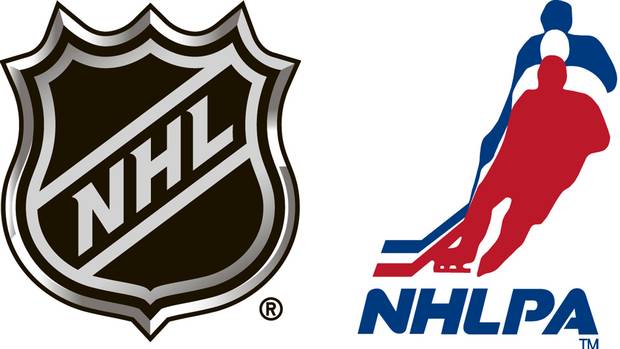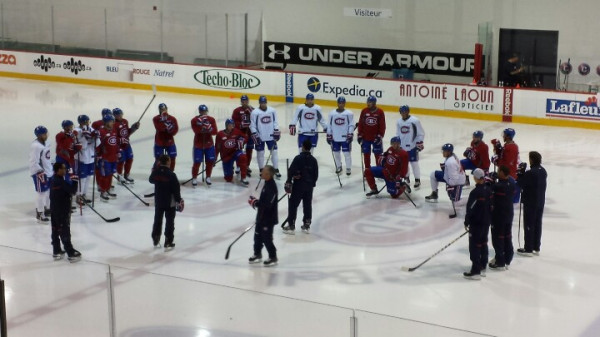By Avi Goldberg, Featured Contributor, All Habs Hockey Magazine
MONTREAL, QC. — I know that we’re all sick and tired of the lockout. And, though it won’t be long before hockey fans in Canada get back into the routine of the games, many of us are also somewhat troubled by what we and local businesses and their workers have had to endure over the last 113 days. As we wait for the sides to ratify the new CBA, and for a feverishly short training camp to prepare for a feverishly short season, I’ve reflected and come up with five issues that summarize what I think went down. I will explore some of these issues again in the future but let’s hope that most of them can now be permanently put to rest.
Issue #1: The ‘Catelli’ Lockout or What Was It All About Anyway?
 Have you ever had the experience of buying your favourite brand of pasta, bringing it home, pouring the uncooked noodles in the pot of boiling water, and thinking that there was less pasta in the box than before? Don’t think that you’ve been hallucinating because this is actually a deliberate strategy by which companies reduce the size of packaging and keep the prices of their products the same in order to maintain their level of profits. This, in my view, is what the NHL lockout was all about.
Have you ever had the experience of buying your favourite brand of pasta, bringing it home, pouring the uncooked noodles in the pot of boiling water, and thinking that there was less pasta in the box than before? Don’t think that you’ve been hallucinating because this is actually a deliberate strategy by which companies reduce the size of packaging and keep the prices of their products the same in order to maintain their level of profits. This, in my view, is what the NHL lockout was all about.
It may be chic to say that the lockout was stupid and unnecessary, but Gary Bettman, the owners, and even the players (more on them below) disagree.
With the cost of doing business higher than it’s even been, and with teams in both established and new US markets struggling financially, Bettman made it abundantly clear that the ‘partnership’ was over and that the players were being paid too much money. By succeeding in reducing the players’ share of HRR, restricting the number of years in their contracts, and by restricting the yearly variance in the amounts that they can be paid (all of this over and above the hard salary cap established the last time around), the NHL achieved the objective of ‘Catelli’ economics. Owners gain more control over hockey production costs by reducing the value they put into the package they deliver to the fans relative to the revenue they generate.
Oh, and in light of the savings, do you think the teams are going to reduce the price they charge the fans for what they consume? Neither do I.
Issue #2: Bettman vs. Fehr
 It’s easy to get lost in hyperbole when talking about Gary Bettman and Donald Fehr but here are some facts. Bettman, who has now overseen three lockouts as league Commissioner, is reported to enjoy employing relentlessly aggressive tactics to land deals that serve his interests. Fehr, meanwhile, came to hockey with the reputation as a straightforward negotiator that is savvy in recognizing the time to use the leverage he has to exert the maximal pressure required to force concessions from his adversary. Having faced Bettman before, and with an embarrassing history of disorganization and incompetence, the NHLPA acted wisely in hiring Fehr for the job. With these two men in charge, the last 113 days were not at all unexpected.
It’s easy to get lost in hyperbole when talking about Gary Bettman and Donald Fehr but here are some facts. Bettman, who has now overseen three lockouts as league Commissioner, is reported to enjoy employing relentlessly aggressive tactics to land deals that serve his interests. Fehr, meanwhile, came to hockey with the reputation as a straightforward negotiator that is savvy in recognizing the time to use the leverage he has to exert the maximal pressure required to force concessions from his adversary. Having faced Bettman before, and with an embarrassing history of disorganization and incompetence, the NHLPA acted wisely in hiring Fehr for the job. With these two men in charge, the last 113 days were not at all unexpected.
Now, aside from their respective backgrounds, here are some of the criticisms directed against the Commissioner and the NHLPA’s hired gun during the lockout.
Bettman doesn’t care about hockey, is an autocrat, is a disciple of a legal/business coterie committed to destroying pro sports, and he was trying to use Lockout 3 to crush the NHLPA.
As for Fehr, he also doesn’t care about hockey, doesn’t communicate transparently with the players, has a track record of destroying ownership, and he was acting as an anti-capitalist mercenary gunning to blow up the salary cap and the NHL’s way of doing business.
I’m neither here to dissect these comments nor to argue that these men are heroes. Far from it. But, if you were the head of a big business in a capitalist economy, would you not do all you could to maintain and maximize your profits? Conversely, if you were a worker whose boss was coming at you and your colleagues to drastically slash your salaries, benefits, and labour rights, would you not do all that you could to speak up and resist?
In short, the ‘Catelli’ lockout was a real world fight over economics and power that showcased a battle of best on best. The two hated figures, with the help of a mediator, pushed each other to the limit. Though it wasn’t pretty, I would argue that it’s a testament to their respective strengths, and possibly even to the mutual respect that they share, that they responded to the realities of the situation and struck a deal to save the season.
So, before the painful memories fade, let’s not forget that the outcome of Bettman vs. Fehr is a lot better than what we got from the major combatants the last time.
Issue #3: Old & New Media
 With old school hockey reporters all over Twitter, it’s not easy to distinguish mass media journalism from digital media communication. That being said, here are a few observations of the role of old and new media in the last 113 days.
With old school hockey reporters all over Twitter, it’s not easy to distinguish mass media journalism from digital media communication. That being said, here are a few observations of the role of old and new media in the last 113 days.
Knowing that many of their readers didn’t really want the details, traditional sports journalists were practically apologizing at times for their work. This is too bad because the quality of what I read ranged from strong to outstanding.
The list is far from representative, but some of my favorites include Elliotte Friedman of CBC for his consistently thoughtful and informative assessments of ongoing events, Michael Grange of Sportsnet for his metaphorical evaluations of the intentions of both players and owners during the dispute, James Mirtle of the Globe and Mail for clear statistical assessments showing the importance of specific CBA terms being negotiated, and Larry Brooks of the New York Post for offering a militant, but reasoned, critique of the NHL’s moves during the conflict. From each of these writers, interested fans were able to learn a lot about what was actually happening.
As for new media communication, Twitter was my go-to. Whether it was for provocation, parody and humour, updates by hockey insiders and legal experts, or just out of the need to vent, Twitter provided a needed interactive platform for hockey fans to survive the ‘Catelli’ lockout. And while systematic data gathering and analysis are needed to draw meaningful and specific insights, there is no doubt that fan and journalist use of digital media altered aspects of the lockout experience from the ones they suffered through before.
Issue #4: The Fans
 A lot was written during the lockout and immediately after the tentative deal was reached about the place of the fans in relation to the conflict. What can the NHL do to mend fences with its fans? What do fans want as compensation for being shut out of hockey? What can the fans do to show they’re angry with the NHL and its players? An assertion throughout these discussions has been that the NHL’s brand could really be in serious trouble this time.
A lot was written during the lockout and immediately after the tentative deal was reached about the place of the fans in relation to the conflict. What can the NHL do to mend fences with its fans? What do fans want as compensation for being shut out of hockey? What can the fans do to show they’re angry with the NHL and its players? An assertion throughout these discussions has been that the NHL’s brand could really be in serious trouble this time.
Companies develop brand images that draw on features of culture to appeal to their customers. Because, however, sports are already a significant part of a community’s culture, their appeal to fans doesn’t depend solely on the production and manipulation of a brand. So, and as we are already seeing in Montreal and on our Twitter timelines, fans will enthusiastically come back to hockey in places where it is a major part of their way of life. It is more in places where hockey is already struggling where fans, like always, will need special inducements to lure them to the arenas.
Journalists have expressed uncharacteristically direct anger about the ‘Catelli’ lockout, and it is also very likely that there will be symbolic protest directed against the NHL and the players once the games resume. But, since the frustration stems more from love than from hate or indifference, fans will warm up to hockey after they take some time to get the negative feelings and thoughts out of their system.
Issue #5: The Future
It is far too early to know the answers, but here are some post-lockout questions to be followed over the course of the next several months and years. Will this be it for Bettman and Fehr? Will there be some intrepid investigative reporting that reveals how and why it took so long for the sides to come to an agreement? How will the specifics of the new CBA play out for the owners and players? Will the CBA help address teams in financial straits or will other actions be required? Will GMs and capologists continue to find creative ways to work the player contract system or has the NHL secured cost certainty once and for all? Finally, what will happen in 2022?
Let’s leave the future for the future. For now, I want to know if Scott Gomez will be bought out? Will Alex Galchenyuk make the team? Will Rene Bourque awake from his slumber. Will Michel Therrien show maturity and be effective his second time around…
Like you, I have a lot of mixed feelings about the ‘Catelli’ lockout, but boy am I happy that hockey is back.
Follow me on Twitter @AviGoldberg








![Prospect Report: Habs Development Camp Testing [GALLERY]](https://habshockeyreport.com/wp-content/uploads/2014/07/IMG_2897.jpg)

![Habs Western Road Trip in Pictures [GALLERY]](https://habshockeyreport.com/wp-content/uploads/2014/03/476898185_slide.jpg)
Professor Goldberg, you wrote the following:
“By succeeding in reducing the players’ share of HRR, restricting the number of years in their contracts, and by restricting the yearly variance in the amounts that they can be paid (all of this over and above the hard salary cap established the last time around), … [the owners] gain more control over hockey production costs by reducing the value they put into the package they deliver to the fans relative to the revenue they generate.”
I’m not clear how the concessions obtained by the owners equate to “reducing the value they put into the package.” How have they reduced the value? Perhaps you can explain, because it sounds like you’re saying that if the players make less money and have shorter contracts, the output they produce on the ice will be diminished. Is that what you believe? How are you defining “value?” Do you think the players will become less competitive? That the hockey will become more boring? That on-ice production (i.e., goals) will go down?
Inquiring minds would like to know.
Hey Habitall,
Thanks for the sharp comment/question and please call me Avi!
I do not think the players will play less hard, that goals and other production will be reduced, or that play will become more boring under this CBA. So, I did not intend that their value will be reduced in terms of what they bring to or produce for their teams, the league, the fans, or for competition as a whole.
My use of the term value builds on the situation in which the players are not only a product that is presented or sold to the fans (whose value in this regard will stay the same) but also human workers who hold a value based on the skills and services they can provide to their employers/teams/owners. It is the latter value that gets reduced, thus saving the owners and the league what gets invested in player remuneration or provided in terms of contracting rights.
So, the player is not just an ‘object’ or service that is sold to fans, but is also a human being who sells his labour and skills to an owner. My definition of value refers to the second exchange relationship not the first!
Enjoy the games!
Hi Avi. Thanks for your response, but if that’s what you were trying to say, you should have used a different analogy. Manufacturers who put less into the package while charging the same are actually giving less to the consumer. That’s not the case here. Who are the consumers when it comes to NHL hockey? It’s not the players; it’s the fans.
The NHL owners are now going to be producing something for their consumers (the fans) that will in all likelihood mean more of the same. And if they raise ticket prices, they are cheating no one, because the box still contains the same amount of pasta — i.e., the product is the not reduced. In other words, what the NHL owners have done is found a way to produce the same amount of pasta for less money; that’s called cost reduction, a.k.a. smart business.
On the other hand, if you feel the players are being exploited, then you should have titled your article something more like “Workers of the world, unite!”
Hey Habitall,
Because we’re dealing with human products, both perspectives are right.
From the perspective of the owners, cost has been reduced while the product quality and quantity may not be adversely affected. From the perspective of the players, the value of what they’ll be paid for providing their work as well as of the terms according to which they can create contract agreements with their bosses is being reduced.
From a profit perspective, it definitely makes great business sense to pay your workers as little as you can.
Hope we’ll talk again.
Thanks.
Avi
Comments are closed.